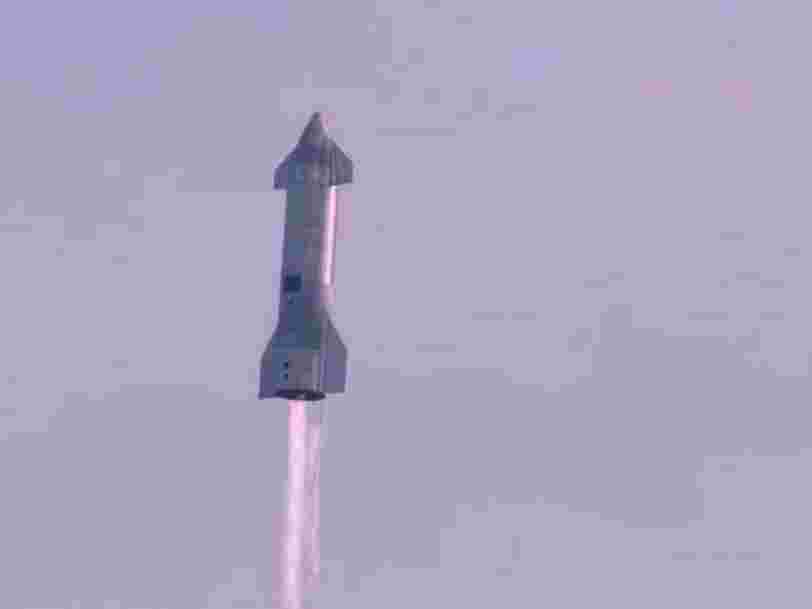Minutes after a seemingly successful landing, SpaceX's Starship rocket exploded on the pad
Morgan McFall-Johnsen | Publié le- SpaceX
-
Recevoir tous les articles sur ce sujet.
Vous suivez désormais les articles en lien avec ce sujet.
Voir mes sujets suivisCe thème a bien été retiré de votre compte

- SpaceX flew a Starship rocket prototype six miles above Texas on Wednesday, landing it in one piece for the first time.
- About ten minutes later, however, the rocket exploded on the landing pad.
- This is Starship's third such test flight. The first two prototypes exploded immediately upon landing .
- Visit the Business section of Insider for more stories .
SpaceX finally launched a prototype of its Starship rocket miles into the air on Wednesday, then landed it successfully. But 10 minutes later, the rocket exploded.
The roughly 16-story test vehicle - called Starship serial No. 10, or SN10 - lifted off at at 5:14 p.m. on Wednesday. As it climbed, it shut off one engine and then another. The rocket hovered at the peak of its flight for about 30 seconds, then cut its last engine, tipped over, and belly-flopped toward the ground.
As it neared the ground, the Raptor engines reignited, flipped SN10 upright, and slowly lowered it to the landing pad.
"Third time's the charm, as the saying goes," John Insprucker, SpaceX's principal integration engineer, declared on the company's livestream.
But a fire persisted around the rocket's skirt. Then about 10 minutes later, an explosion thrust SN10 back into the air, leaving it in pieces on the landing pad.
The prototype's predecessors, SN8 and SN9, completed similar high-altitude flights but flubbed their landings. They each slammed into the landing pad and immediately blew up. Still, those flights - and this one - demonstrated that Starship could rocket to high altitudes and control its plummet back to Earth. On Wednesday, SN10 showed that it can land on the ground in one piece, too - at least initially.
A 2-part, fully reusable launch system
SpaceX broadcast the test flight, which you can watch in the YouTube video below, minus the delayed explosion. To start, Starship's three truck-sized Raptor engines roared to life, heaved it off the ground, and rumbled past the launchpad at SpaceX's facilities in Boca Chica, a remote strip of land in southeastern Texas. After it began its descent, two aerodynamic wing flaps at the rocket's nosecone and two at its base - operated by an on-board computer - moved independently to control SN10's fall and maintain its belly-flop position.
SN10 is the upper stage of a system designed to have two parts: A roughly 23-story booster called Super Heavy would one day heave the Starship spaceship toward orbit.
If it works, the Starship-Super Heavy launch system could slash the cost of reaching space 1,000-fold, since it would eliminate the need to build new rockets and spaceships for each spaceflight. Musk wants to construct a fleet of reusable Starships to power round-the-world hypersonic travel on Earth, fly astronauts to the moon , and one day carry people to Mars .
An eventual flight to low-Earth orbit
Once SpaceX figures out how Starship can nail its launch and landing, the company will want to rocket a prototype into orbit to test its ability to reenter Earth's atmosphere. That will require a new type of launch license from the Federal Aviation Administration, but obtaining it involves clearing many regulatory hurdles, including a thorough environmental assessment. Depending on the findings of that assessment, it's possible SpaceX may need to conduct a new environmental impact statement, which could take up to three years.
Complicating matters is a leaked FAA draft document obtained by Insider , which revealed that SpaceX plans to dig natural gas wells and build gas-fired power plants in Boca Chica. Such plans could prolong SpaceX's environmental review process.
Musk and the FAA have clashed before: SpaceX launched its first high-altitude Starship flight, for its SN8 prototype, without FAA approval, which triggered an investigation.
That inquiry was still ongoing, as was another investigation into the causes of SN8's explosive landing, at the time SpaceX wanted to launch its next Starship prototype, SN9. In January, SpaceX announced that the SN9 was about to fly. But as the rocket sat ready on the launchpad, the FAA suddenly yanked the airspace closure that made way for the rocket's path. There was no launch that day.
In response to the delay, Musk railed against the FAA on Twitter , saying its space division had "a fundamentally broken regulatory structure" and that "humanity will never get to Mars" under its rules.
The following week, the FAA approved the SN9 launch license updates and gave SpaceX the green light. The rocket soared and crashed, much like its predecessor.
Musk says he is "highly confident" SpaceX will launch an uncrewed Starship to Mars in 2024, followed by a crewed mission in 2026.
Inscrivez-vous gratuitement à notre newsletter quotidienne
Via PakApNews